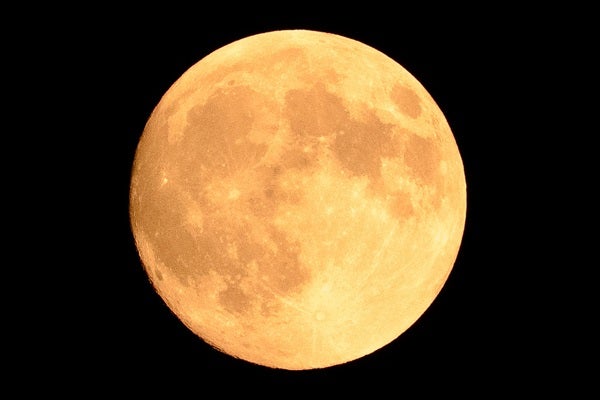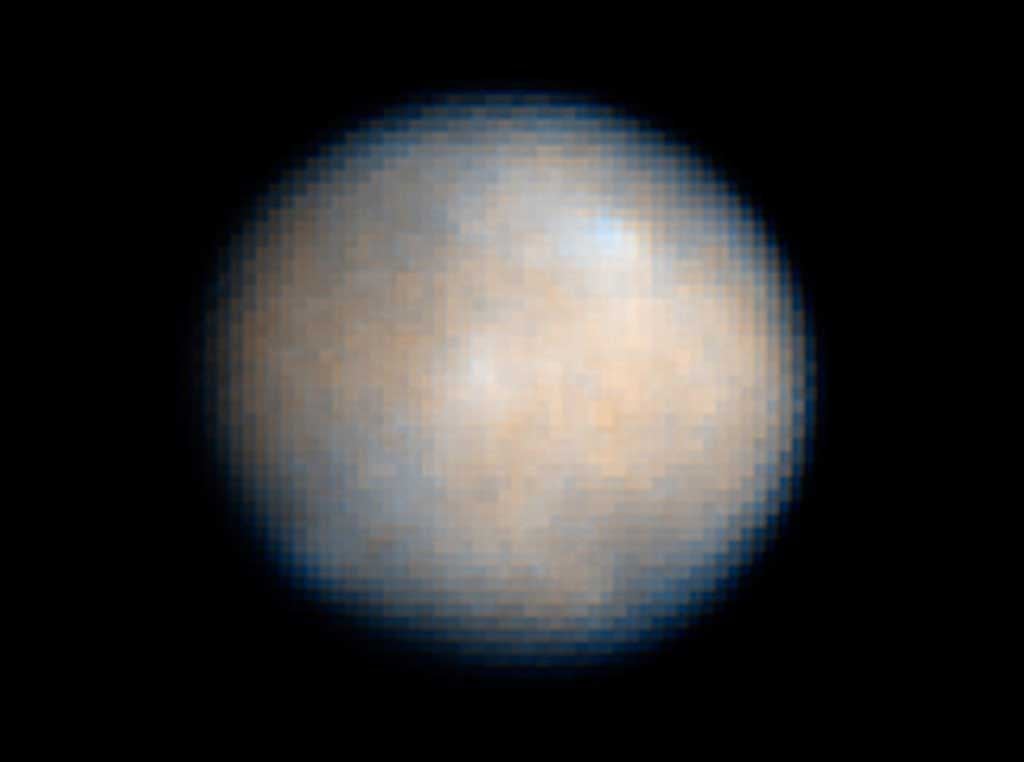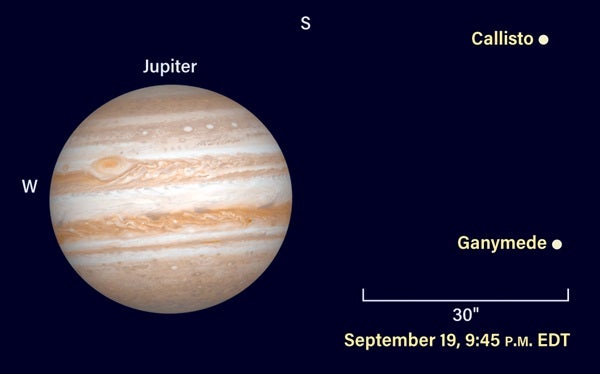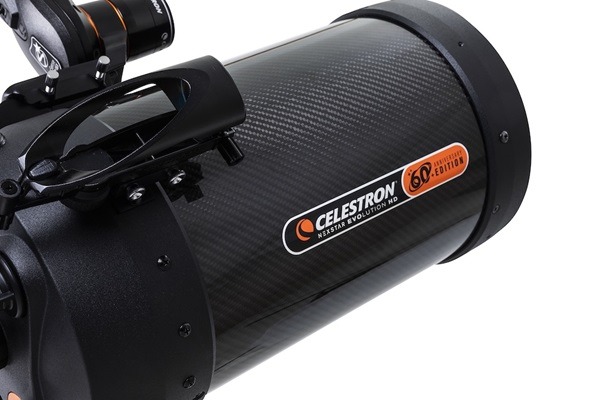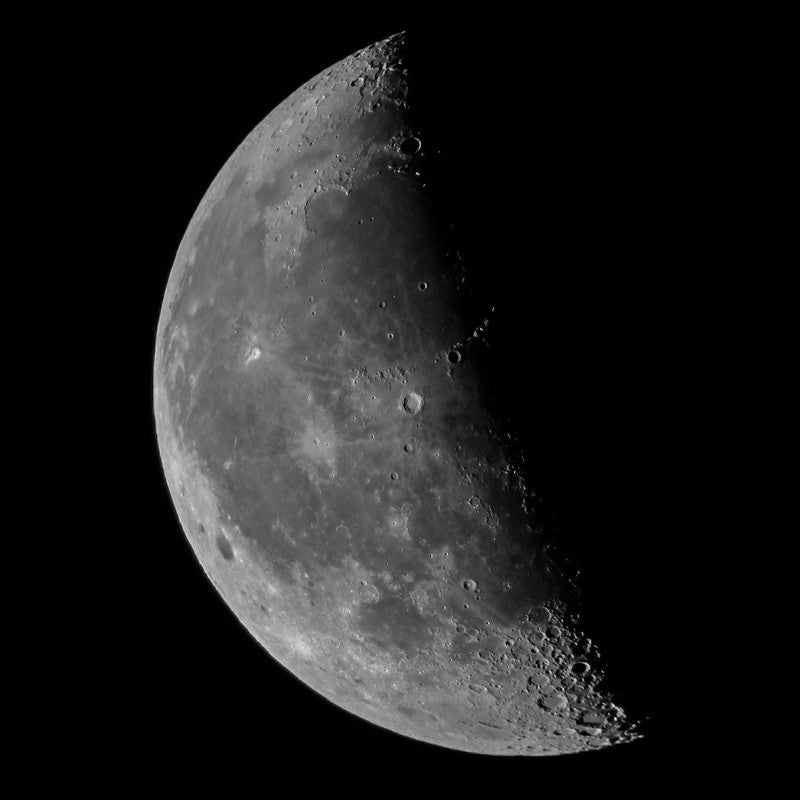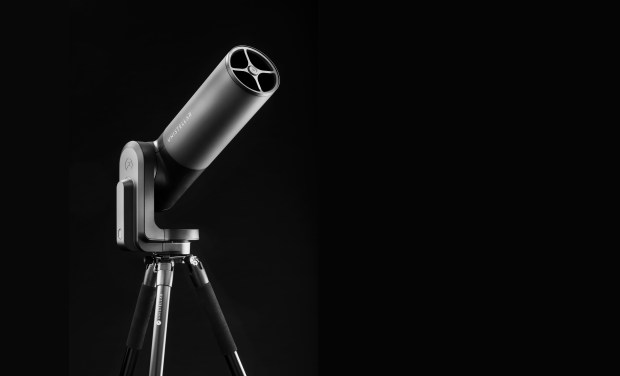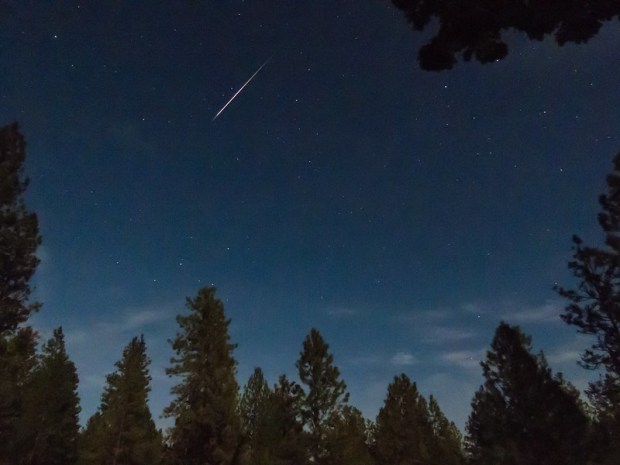Full Moon arrives at 12:33 a.m. EDT tomorrow morning (9:33 p.m. PDT this evening), so our satellite looks completely illuminated all night. Luna rises in the east shortly after the Sun sets and peaks in the south around 1 a.m. local daylight time. The Moon lies among the dim background stars of eastern Aquarius, due south of the Great Square of Pegasus. As the Full Moon closest to the autumnal equinox, this is also the Harvest Moon. In early autumn, the Full Moon rises about half an hour later each night compared with a normal lag close to 50 minutes. The added early evening illumination supposedly helps farmers bringing in their crops.
The Moon also reaches apogee, the farthest point in its orbit around Earth, today. At 9:32 a.m. EDT, it lies 252,511 miles (406,377 kilometers) from Earth’s center.
Saturday, September 14
Jupiter continues to dominate the evening sky from its perch in southern Ophiuchus the Serpent-bearer. The giant planet shines at magnitude –2.1 and stands some 20° above the southwestern horizon as twilight fades to darkness. When viewed through a telescope, the planet shows a 38″-diameter disk and striking details in its dynamic atmosphere.
The dwarf planet Ceres reached opposition in May, but it remains a tempting target in the evening sky thanks to its proximity to the 1st-magnitude star Antares in Scorpius the Scorpion. Even better, magnitude 9.0 Ceres currently lies against a star-poor dust lane in the otherwise rich Milky Way background. This evening, Ceres stands 2.9° due north of Antares, and the nearest star that outshines the dwarf planet lies 1° away. Identifying the solar system object from the suburbs should be easy through a small telescope, and those blessed with dark skies should be able to spot it through binoculars.
Monday, September 16
Although Neptune appeared at its best at opposition a week ago, its visibility hardly suffers this week. The outermost major planet lies low in the southeast as darkness falls and climbs highest in the south around midnight local daylight time. Neptune glows at magnitude 7.8, which is bright enough to spot through binoculars if you know where to look. The trick is to find the 4th-magnitude star Phi (φ) Aquarii, which lies about 15° (two binocular fields) east-southeast of Aquarius’ distinctive Water Jar asterism. Tonight, Neptune appears just 0.3° west-southwest of Phi. When viewed through a telescope, the ice giant planet shows a blue-gray disk measuring 2.4″ across.
Tuesday, September 17
Neptune’s neighbor in the outer solar system, Uranus, also puts on a nice show this week. It rises shortly after the last vestiges of twilight fade away and climbs 25° high in the east by 11 p.m. local daylight time. It reaches its peak some 60° above the southern horizon at 3:30 a.m. The ice giant planet glows at magnitude 5.7 against the backdrop of southern Aries the Ram. Use binoculars to find the planet 2.3° south of the similarly bright star 19 Arietis. A telescope reveals Uranus’ blue-green disk, which spans 3.7″.
Wednesday, September 18
Magnificent Saturn reached its peak more than two months ago, but our view of the ringed planet remains spectacular. It resides among the background stars of Sagittarius the Archer, a region that appears highest in the south during the latter stages of twilight and doesn’t set until 1 a.m. local daylight time. Saturn continues to shine brightly, too, at magnitude 0.4. When viewed through a telescope, the planet’s disk measures 17″ across while the dramatic ring system spans 39″ and tilts 25° to our line of sight.
The waning gibbous Moon rises in the east shortly after 10 p.m. local daylight time. Wait about an hour for it to climb clear of the horizon and you’ll see it nestled just above the background stars of the Hyades star cluster in the constellation Taurus the Bull. Binoculars will deliver the best views of this pretty conjunction. As the night progresses, you’ll see the Moon draw closer to 1st-magnitude Aldebaran. This star, which appears to anchor the V-shaped Hyades, actually lies only half as far away.
Jupiter’s four bright moons all orbit in the planet’s equatorial plane, so from our perspective, they usually appear in a straight line that runs east-west. But this symmetry breaks down once in a while. If you target the gas giant through a telescope this evening, you’ll notice its two biggest moons lined up north-south of each other. If you keep watching, you’ll see Ganymede and Callisto change relative positions in as little as five minutes.
Friday, September 20
Any clear evening this week is a good time to explore the constellation Sagittarius the Archer. This star group lies due south and at peak altitude during the latter stages of twilight and remains conspicuous until after 10 p.m. local daylight time. The brightest stars within the constellation form a distinctive asterism in the shape of a teapot. The central regions of the Milky Way pass through Sagittarius, so it’s always worth exploring this region through binoculars or a telescope.
Saturday, September 21
Last Quarter Moon arrives at 10:41 p.m. EDT. It rises about 20 minutes before midnight local daylight time and will climb high in the southeast as dawn approaches. During this period, our half-lit satellite slides eastward along the border that separates the constellations Orion the Hunter and Gemini the Twins.
Sunday, September 22
Although autumn arrives with the equinox tomorrow, the Summer Triangle remains prominent in the evening sky. Look high in the west after darkness falls and your eyes will fall on the brilliant star Vega in the constellation Lyra the Harp. At magnitude 0.0, Vega is the brightest member of the triangle. The second-brightest star, magnitude 0.8 Altair in Aquila the Eagle, lies some 35° southeast of Vega. The asterism’s dimmest member, magnitude 1.3 Deneb in Cygnus the Swan, stands about 25° east-northeast of Vega. For observers at mid-northern latitudes, Deneb passes through the zenith at approximately 9:30 p.m. local daylight time, about an hour after twilight ends.

